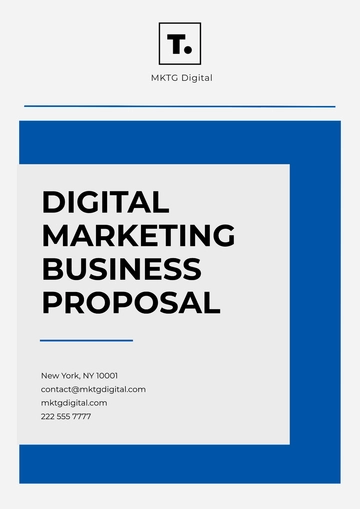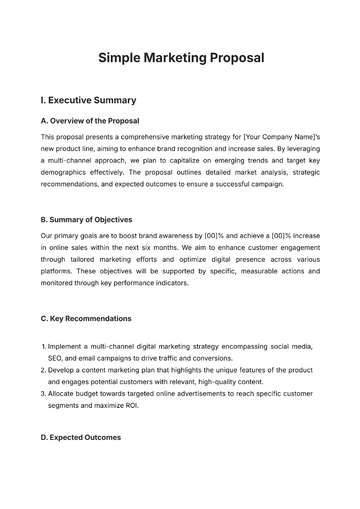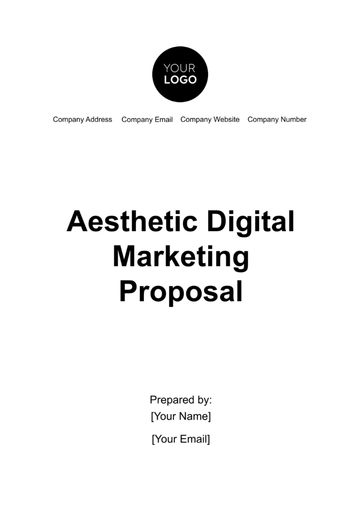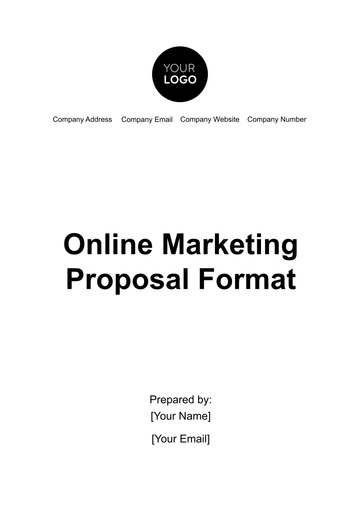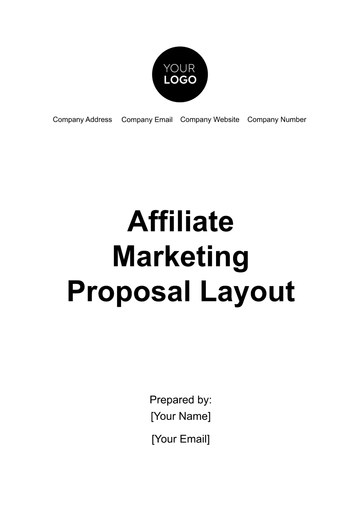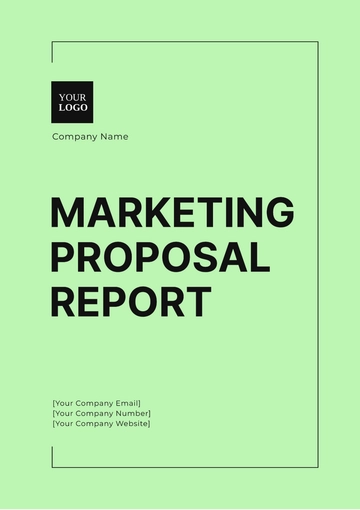Free Aesthetic Digital Marketing Proposal

I. Introduction
A. Overview of the Client’s Business
[Your Company Name] is a leading e-commerce platform that has quickly gained recognition for its commitment to sustainability and eco-friendly products. Founded in [Year], the company has built a diverse catalog of over 500 products, ranging from everyday essentials to innovative green solutions. With a rapidly growing customer base, [Your Company Name] is poised to become a dominant player in the eco-conscious market.
B. Purpose of the Proposal
This proposal aims to outline a strategic digital marketing plan that will propel [Your Company Name] to new heights in the online marketplace. By leveraging advanced digital marketing techniques, the proposal seeks to increase brand visibility, drive targeted traffic, and ultimately boost sales. The goal is to align our digital strategies with [Your Company Name]’s mission of promoting sustainable living and expanding its market reach.
C. Statement of the Client’s Goals
[Your Company Name] aims to achieve a [00]% increase in online sales over the next 12 months, with a strong focus on enhancing customer engagement and brand loyalty. Additionally, the company seeks to expand its social media following by [00]%, particularly on platforms like Instagram and Pinterest, where its target audience is most active. These goals will be met through a combination of content marketing, SEO, and targeted advertising campaigns.
II. Executive Summary
A. Summary of Proposed Strategy
Our digital marketing strategy for [Your Company Name] will employ a multi-channel approach, integrating SEO, content marketing, social media, PPC advertising, and email marketing to create a cohesive online presence. By targeting key demographics with personalized content and optimizing all digital touchpoints, we aim to increase both organic and paid traffic to [Your Company Name]’s website. This approach will not only enhance brand awareness but also convert visitors into loyal customers through strategic engagement and follow-up.
B. Key Objectives and Expected Outcomes
The primary objective is to generate a [00]% increase in website traffic within six months, leading to a significant boost in online sales and customer engagement. We expect to achieve a 5:1 return on ad spend (ROAS) through our targeted PPC campaigns, which will focus on high-intent keywords and retargeting strategies. Additionally, our content marketing efforts will aim to position [Your Company Name] as a thought leader in the eco-friendly products industry, resulting in increased brand credibility and customer loyalty.
C. Unique Value Proposition
[Your Company Name]’s commitment to sustainability sets it apart in a crowded marketplace, offering consumers not just products but a lifestyle choice that aligns with their values. Our proposed digital marketing strategy will amplify this unique value proposition by telling compelling stories through content, engaging visuals, and impactful campaigns. By focusing on the company’s strengths and aligning our strategies with market trends, we will ensure that [Your Company Name] stands out as a trusted and innovative brand in the eco-conscious community.
III. Market Research
A. Target Audience Analysis
Demographics
[Your Company Name]’s target audience primarily includes environmentally conscious consumers aged 25-45, with a higher representation of women who are often the primary decision-makers in household purchases. These consumers are typically well-educated, urban professionals with disposable income, allowing them to invest in sustainable products. Their purchasing decisions are heavily influenced by ethical considerations, making them loyal to brands that align with their values.
Psychographics
The target audience is deeply committed to sustainability, often going out of their way to research and support companies that share their values. They are not just buyers but advocates for the green movement, frequently sharing their eco-friendly practices on social media and influencing others in their networks. Their loyalty is earned through transparency, quality, and consistent ethical practices, making them valuable long-term customers.
Online Behavior
This audience spends significant time online, particularly on social media platforms like Instagram and Pinterest, where they seek inspiration and product recommendations. They are proactive in searching for eco-friendly alternatives via search engines, and they frequently engage with content that educates them on sustainable living. They are also likely to subscribe to newsletters and follow blogs that offer tips and updates on green products and practices.
B. Competitor Analysis
Competitors' Digital Presence
[Your Company Name]’s main competitors, [Competitor A] and [Competitor B], maintain robust digital presences with strong followings on Instagram and high visibility in search engine results. [Competitor A] excels in influencer marketing, driving engagement through collaborations with well-known eco-conscious personalities. [Competitor B], on the other hand, has built its success on a well-optimized website and a content-rich blog that attracts organic traffic.
Strengths and Weaknesses
While both competitors have established strong brands, they also have notable weaknesses. [Competitor A]’s reliance on influencers makes it vulnerable to shifts in social media algorithms and influencer marketing trends. [Competitor B], despite its strong SEO, lacks a dynamic social media strategy, resulting in lower engagement and customer interaction. [Your Company Name] can capitalize on these gaps by offering a more integrated digital strategy that combines the strengths of both competitors.
Market Positioning
[Your Company Name] is uniquely positioned to lead the market by emphasizing its commitment to innovation in sustainable products and customer education. Unlike its competitors, [Your Company Name] can leverage its diverse product range and focus on emerging trends, such as zero-waste packaging and carbon-neutral shipping, to attract a broader audience. By positioning itself as not just a retailer but a thought leader in sustainability, [Your Company Name] can build a strong, loyal customer base.
C. Industry and Market Trends
Current Digital Marketing Trends
Video content continues to dominate digital marketing, with short-form videos on platforms like TikTok and Instagram Reels proving highly effective for engagement. Brands are increasingly using these formats to create authentic, relatable content that resonates with their audiences. Additionally, the rise of social commerce, where consumers can purchase directly through social media platforms, is transforming the online shopping experience, offering new opportunities for growth.
Emerging Technologies and Platforms
AI-driven personalization is becoming a key trend, allowing brands to tailor content, recommendations, and ads to individual users based on their online behavior. This technology enhances user experience and increases conversion rates by delivering relevant content at the right time. Additionally, the growing popularity of platforms like Clubhouse and emerging social networks provides new avenues for brand engagement and community building.
IV. Marketing Objectives
A. Short-Term Goals (3-6 months)
Within the first three months, we aim to increase [Your Company Name]’s website traffic by [00]% through targeted SEO and content marketing efforts. This will involve optimizing existing content, creating new blog posts, and improving site architecture to enhance search engine visibility. Additionally, we plan to launch a PPC campaign focused on high-intent keywords to drive immediate traffic and conversions, with a goal of achieving a 3:1 return on ad spend (ROAS).
B. Long-Term Goals (6-12 months and beyond)
Over the next 6 to 12 months, we will work towards achieving a [00]% increase in online sales by expanding [Your Company Name]’s digital footprint and improving conversion rates. This will include a sustained focus on content marketing, social media engagement, and the introduction of new product lines tailored to emerging consumer trends. By the end of the year, we aim to establish [Your Company Name] as a recognized leader in the sustainable products market, with a [00]% increase in social media following and enhanced customer loyalty.
C. Key Performance Indicators (KPIs)
We will track the success of our digital marketing efforts through a set of key performance indicators, including website traffic, conversion rates, and social media engagement. Specifically, we aim to increase unique website visitors by [00]%, achieve a [00]% conversion rate on e-commerce transactions, and grow social media engagement by [00]%. Additionally, we will monitor email open rates and click-through rates to assess the effectiveness of our email marketing campaigns, with a target of maintaining open rates above [00]% and click-through rates above [00]%.
V. Proposed Strategy
A. Search Engine Optimization (SEO)
On-Page Optimization
We will begin by optimizing [Your Company Name]’s website content for relevant keywords related to eco-friendly products and sustainable living. This includes refining meta titles and descriptions, improving internal linking, and ensuring all images have appropriate alt text. Additionally, we will enhance product pages with detailed descriptions and customer reviews to increase relevance and engagement.
Off-Page Optimization
Off-page SEO efforts will focus on building high-quality backlinks from authoritative websites within the sustainability and eco-friendly niche. We will pursue guest blogging opportunities, collaborate with industry influencers for content sharing, and participate in relevant forums and online communities. These efforts will not only improve search engine rankings but also drive targeted referral traffic to [Your Company Name]’s website.
Technical SEO
A thorough technical SEO audit will be conducted to identify and fix any issues that may hinder search engine crawling and indexing. We will ensure that [Your Company Name]’s website is mobile-friendly, has fast loading times, and is free of broken links. Additionally, we will implement structured data to enhance search engine understanding of the site’s content, leading to better visibility in search results.
B. Content Marketing
Content Creation
Our content strategy will focus on creating high-quality, SEO-optimized blog posts, articles, and infographics that educate and engage [Your Company Name]’s target audience. Topics will include sustainable living tips, product benefits, and customer success stories. Additionally, we will develop video content for social media platforms, showcasing product demonstrations, customer testimonials, and behind-the-scenes looks at [Your Company Name]’s sustainable practices.
Content Distribution
Content will be distributed across multiple channels to maximize reach and engagement. Blog posts will be published on [Your Company Name]’s website and shared on social media, while infographics and videos will be promoted through email newsletters and social media campaigns. We will also explore partnerships with eco-friendly blogs and websites to feature [Your Company Name]’s content, further extending its reach.
Content Calendar
A detailed content calendar will be developed to ensure a consistent and strategic approach to content marketing. The calendar will outline the topics, formats, and publishing schedule for all content, ensuring that it aligns with key marketing objectives and seasonal trends. Regular reviews and adjustments will be made to keep the content relevant and engaging for the target audience.
C. Social Media Marketing
Platform Strategy
We will focus our social media efforts on platforms where [Your Company Name]’s target audience is most active, including Instagram, Pinterest, and Facebook. Each platform will have a tailored strategy, with Instagram and Pinterest emphasizing visual content, such as product images, infographics, and videos. Facebook will be used for more in-depth content, including articles, customer stories, and community engagement initiatives.
Engagement Tactics
To foster engagement, we will implement interactive content such as polls, quizzes, and contests that encourage audience participation. Additionally, we will actively respond to comments, messages, and reviews to build a strong, positive relationship with the online community. Collaborations with influencers and eco-conscious bloggers will also be pursued to expand reach and credibility.
Content Scheduling and Management
A social media content calendar will be established to ensure consistent posting and strategic timing. We will use social media management tools to schedule posts, monitor performance, and adjust strategies as needed. Regular analysis of engagement metrics will guide content adjustments, ensuring that [Your Company Name]’s social media presence remains vibrant and effective.
D. Pay-Per-Click Advertising (PPC)
Keyword Strategy
A comprehensive keyword analysis will be conducted to identify high-intent, low-competition keywords that align with [Your Company Name]’s products and target audience. These keywords will form the basis of our PPC campaigns, ensuring that ads are displayed to users who are actively searching for eco-friendly products. Negative keywords will also be used to exclude irrelevant searches, maximizing the efficiency of the ad spend.
Ad Creation
We will develop a series of compelling, targeted ads that highlight the unique benefits of [Your Company Name]’s products, such as sustainability, quality, and innovation. Ad copy will be crafted to resonate with the eco-conscious audience, using strong calls to action and persuasive language. Visuals will be carefully selected to complement the ad copy and capture the attention of potential customers.
Budget Management
The PPC budget will be strategically allocated across different platforms and campaigns to maximize ROI. We will start with a higher investment in Google Ads, focusing on search and shopping campaigns, and allocate a portion of the budget to social media ads on platforms like Instagram and Facebook. Regular performance reviews will allow us to reallocate funds to the best-performing campaigns, ensuring optimal use of the budget.
VI. Budget and Resource Allocation
A. Budget Breakdown
We propose a total budget of $[00], with $[00] allocated to PPC, $[00] to content marketing, and the remaining for social media and SEO efforts. This distribution ensures a balanced approach to maximizing visibility and engagement across all channels.
B. Resource Allocation
Team Roles and Responsibilities
A dedicated team will manage each aspect of the digital marketing strategy, including a project manager, content strategist, and specialists for SEO, social media, and PPC. This structure ensures that all tasks are efficiently handled and aligned with the overall goals.
External Vendors and Partnerships
We will collaborate with external partners for specialized services, such as influencer marketing and video production. These partnerships will enhance the campaign’s effectiveness and ensure high-quality content and execution.
VII. Timeline
A. Phased Implementation Plan
Initial Setup and Launch (Weeks 1-4) | We will focus on setting up tools, launching PPC campaigns, and beginning influencer outreach. This phase will lay the foundation for the entire digital marketing strategy. |
Ongoing Management and Optimization (Months 1-3) | Continuous monitoring and optimization will be carried out to refine SEO, PPC, content, and social media efforts. This ensures that we adapt to performance data and market trends. |
Review and Adjustments (Months 3-6) | A thorough review of all activities will be conducted at the three-month mark to assess progress. Based on insights, we will make necessary adjustments to improve results. |
B. Milestones and Deadlines
Key milestones include completing setup by Week 4, increasing website traffic by [00]% in the first month, and achieving a [00]% increase in online sales by Month 6. These goals will guide our progress and success.
C. Contingency Planning
We will prepare for potential challenges, such as market shifts or budget constraints, by developing backup strategies. This ensures that we can maintain momentum and meet objectives despite any disruptions.
VIII. Measurement and Analytics
A. Tracking and Reporting Tools
We will use tools like Google Analytics, Search Console, and social media analytics to monitor performance. These tools provide insights that will guide our decisions and optimizations.
B. Performance Metrics
Key metrics include website traffic, conversion rates, and ROI, which will be tracked to measure the success of our efforts. We aim to increase website traffic by [00]% and achieve a [00]% conversion rate.
C. Regular Reporting and Insights
Monthly reports will provide detailed performance updates, while quarterly reviews will assess overall success and guide strategy adjustments. This regular analysis ensures we stay on track to meet our goals.
IX. Risk Management
A. Identification of Potential Risks
Potential risks include market volatility, budget constraints, and operational challenges. Identifying these risks early allows us to prepare and minimize their impact.
B. Mitigation Strategies
We will monitor market trends, control budget spending, and streamline operations to mitigate risks. This proactive approach helps ensure smooth execution of the strategy.
C. Contingency Planning
Alternative strategies will be ready to deploy if certain aspects of the plan underperform. A crisis management plan will also be in place to address any major disruptions quickly.
X. Conclusion and Next Steps
A. Recap of Proposal Highlights
This proposal outlines a multi-channel digital marketing strategy designed to drive traffic, increase conversions, and enhance brand visibility. It includes detailed plans for budgeting, timelines, and risk management.
B. Benefits of the Proposed Strategy
The strategy will improve search engine visibility, strengthen customer relationships, and deliver a high ROI. By targeting eco-conscious consumers, [Your Company Name] will increase brand loyalty and market leadership.
C. Call to Action and Implementation Plan
To move forward, we recommend a kickoff meeting to finalize the plan and begin implementation. Our team is ready to start executing the strategy and delivering measurable results within the first three months.
- 100% Customizable, free editor
- Access 1 Million+ Templates, photo’s & graphics
- Download or share as a template
- Click and replace photos, graphics, text, backgrounds
- Resize, crop, AI write & more
- Access advanced editor
Elevate your marketing strategy with Template.net's Aesthetic Digital Marketing Proposal Template. This editable and fully customizable template is designed to streamline your proposal creation process. Featuring an intuitive AI Editor Tool, it allows for effortless adjustments and personalized touches, ensuring your proposals are both professional and unique. Perfect for making a lasting impression.
You may also like
- Business Proposal
- Research Proposal
- Proposal Request
- Project Proposal
- Grant Proposal
- Photography Proposal
- Job Proposal
- Budget Proposal
- Marketing Proposal
- Branding Proposal
- Advertising Proposal
- Sales Proposal
- Startup Proposal
- Event Proposal
- Creative Proposal
- Restaurant Proposal
- Blank Proposal
- One Page Proposal
- Proposal Report
- IT Proposal
- Non Profit Proposal
- Training Proposal
- Construction Proposal
- School Proposal
- Cleaning Proposal
- Contract Proposal
- HR Proposal
- Travel Agency Proposal
- Small Business Proposal
- Investment Proposal
- Bid Proposal
- Retail Business Proposal
- Sponsorship Proposal
- Academic Proposal
- Partnership Proposal
- Work Proposal
- Agency Proposal
- University Proposal
- Accounting Proposal
- Real Estate Proposal
- Hotel Proposal
- Product Proposal
- Advertising Agency Proposal
- Development Proposal
- Loan Proposal
- Website Proposal
- Nursing Home Proposal
- Financial Proposal
- Salon Proposal
- Freelancer Proposal
- Funding Proposal
- Work from Home Proposal
- Company Proposal
- Consulting Proposal
- Educational Proposal
- Construction Bid Proposal
- Interior Design Proposal
- New Product Proposal
- Sports Proposal
- Corporate Proposal
- Food Proposal
- Property Proposal
- Maintenance Proposal
- Purchase Proposal
- Rental Proposal
- Recruitment Proposal
- Social Media Proposal
- Travel Proposal
- Trip Proposal
- Software Proposal
- Conference Proposal
- Graphic Design Proposal
- Law Firm Proposal
- Medical Proposal
- Music Proposal
- Pricing Proposal
- SEO Proposal
- Strategy Proposal
- Technical Proposal
- Coaching Proposal
- Ecommerce Proposal
- Fundraising Proposal
- Landscaping Proposal
- Charity Proposal
- Contractor Proposal
- Exhibition Proposal
- Art Proposal
- Mobile Proposal
- Equipment Proposal
- Student Proposal
- Engineering Proposal
- Business Proposal















